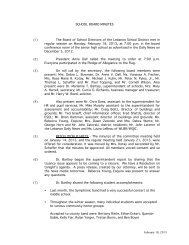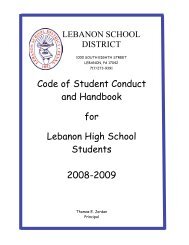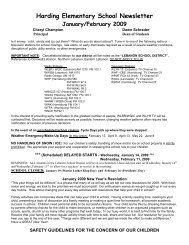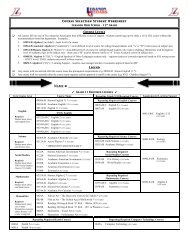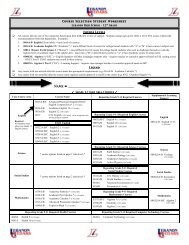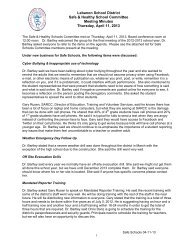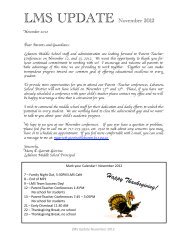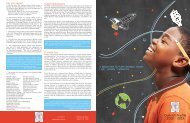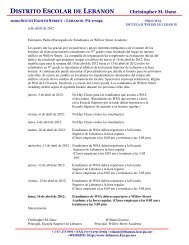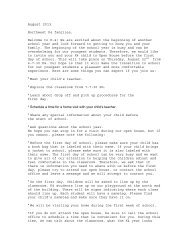Guide to Advising the College Bound Student âAthlete - Lebanon ...
Guide to Advising the College Bound Student âAthlete - Lebanon ...
Guide to Advising the College Bound Student âAthlete - Lebanon ...
You also want an ePaper? Increase the reach of your titles
YUMPU automatically turns print PDFs into web optimized ePapers that Google loves.
GUIDE TO ADVISING THE COLLEGE BOUND STUDENT ATHLETE<br />
<strong>the</strong> recruiting process<br />
DIVISION III<br />
Overview<br />
The NCAA does not regulate recruiting practices of<br />
Division III institutions <strong>to</strong> <strong>the</strong> degree that it regulates<br />
those of Division I & II institutions. In spite of this, <strong>the</strong><br />
steps of <strong>the</strong> recruiting process remain very similar, but<br />
with variations in order of occurrence.<br />
<strong>Student</strong> athletes aspiring <strong>to</strong> participate at this level are<br />
not required <strong>to</strong> submit applications <strong>to</strong> <strong>the</strong> Eligibility<br />
Center or complete <strong>the</strong> Amateurism Certificate (a<br />
questionnaire <strong>to</strong> asses if you have received money/<br />
compensation during your athletic career), and <strong>the</strong>y are<br />
not bound by <strong>the</strong> National Letter of Intent (NLI).<br />
However, <strong>the</strong>se institutions set very high standards for<br />
<strong>the</strong>ir students and determine amateur status at <strong>the</strong><br />
institutional level.<br />
The biggest difference between scholarship and nonscholarship<br />
institutions is:<br />
Division I & II institutions try <strong>to</strong> sell <strong>the</strong>ir programs,<br />
with <strong>the</strong> climax being <strong>the</strong> decision <strong>to</strong> offer<br />
scholarships.<br />
Division III schools are not working with scholarship<br />
money (everyone who qualifies gets a financial aid<br />
package).<br />
Division III schools can call as often as <strong>the</strong>y want.<br />
Visits <strong>to</strong> Division III schools do not count as official<br />
visits.<br />
Step 1 -- Initial Contact<br />
This typically comes in <strong>the</strong> form of a questionnaire<br />
<strong>College</strong>s sometimes contact <strong>the</strong> School Counselor <strong>to</strong><br />
release transcript/test scores -- <strong>the</strong> LHS Counseling<br />
Department will not release information without <strong>the</strong><br />
consent of <strong>the</strong> student<br />
Step 2 -- Campus Visit/Application<br />
Once <strong>the</strong> coaching staff has seen a few games (ei<strong>the</strong>r<br />
in person or via video footage), <strong>the</strong>y will make a<br />
serious attempt <strong>to</strong> get <strong>the</strong> student athlete on campus<br />
for a visit -- visits typically consist of a <strong>to</strong>ur, lunch,<br />
and a meeting with <strong>the</strong> head coach -- coaches will<br />
often invite higher profile recruits for overnight visits<br />
and -- by <strong>the</strong> time of an overnight visit, coaches hope<br />
that an application for admission has already been<br />
made<br />
Step 3 -- Financial Aid Package<br />
Packages typically consist of grant, loan, and work<br />
study money. This is where academics really matter!<br />
The attractiveness of <strong>the</strong> package which a student<br />
receives is highly dependent upon how well <strong>the</strong><br />
student fits <strong>the</strong> profile of <strong>the</strong> school<br />
Note: <strong>the</strong> term “student athlete” is not used due <strong>to</strong> NCAA<br />
rule -- students at <strong>the</strong> Division III level are not <strong>to</strong> be<br />
designated as “prospective student athletes” because<br />
financial aid is not based on athletics <strong>to</strong> any degree<br />
The better <strong>the</strong> student, <strong>the</strong> more grant money, and<br />
less loan and/or work study received<br />
The lesser <strong>the</strong> student, <strong>the</strong> less grant money and<br />
more loan and/or work study money received<br />
Step 4 -- Home Visit (only if needed)<br />
If <strong>the</strong> coaching staff regards you as a <strong>to</strong>p recruit and<br />
believes you are “on <strong>the</strong> fence” in terms of enrolling,<br />
<strong>the</strong> head coach (and possibly a <strong>to</strong>p assistant) will<br />
conduct a home visit in an effort <strong>to</strong> show <strong>the</strong><br />
prospective student athlete <strong>the</strong> high degree <strong>to</strong> which<br />
<strong>the</strong>y are interested<br />
Step 5 -- Commitment<br />
For Division III institutions, a commitment first comes<br />
as a verbal statement (nothing is ever in writing and/<br />
or binding).<br />
Final commitment is perceived when <strong>the</strong> student<br />
athlete pays a room deposit and registers for classes<br />
Page 26



